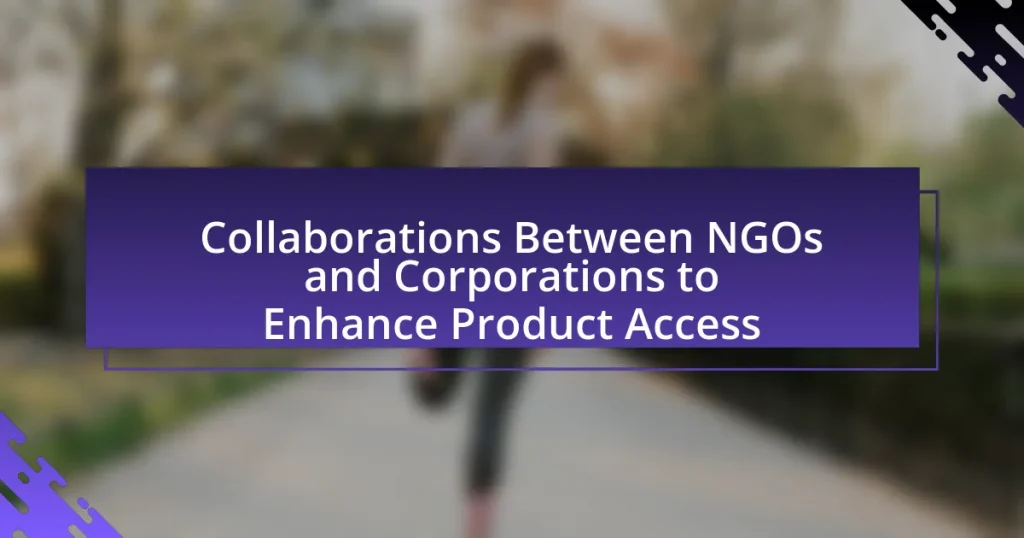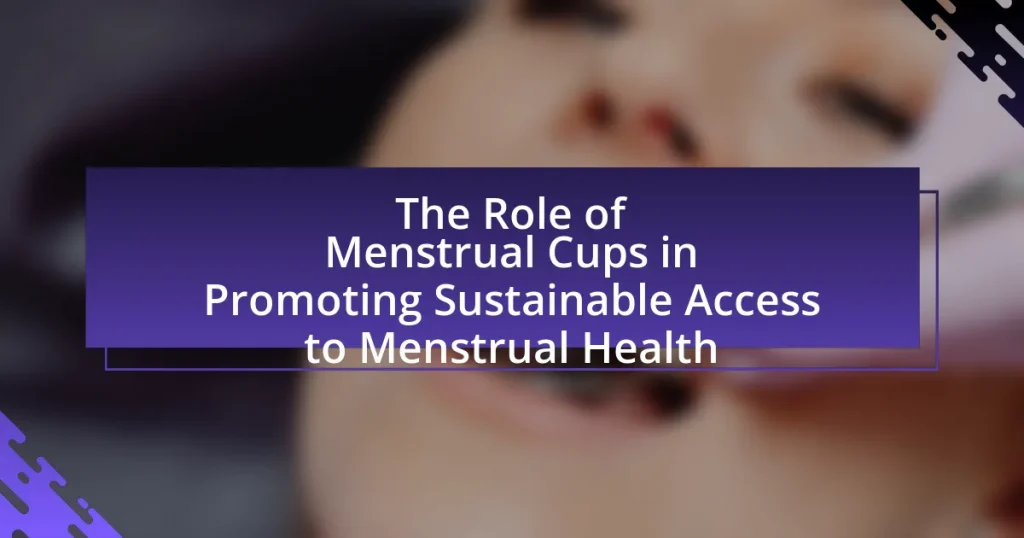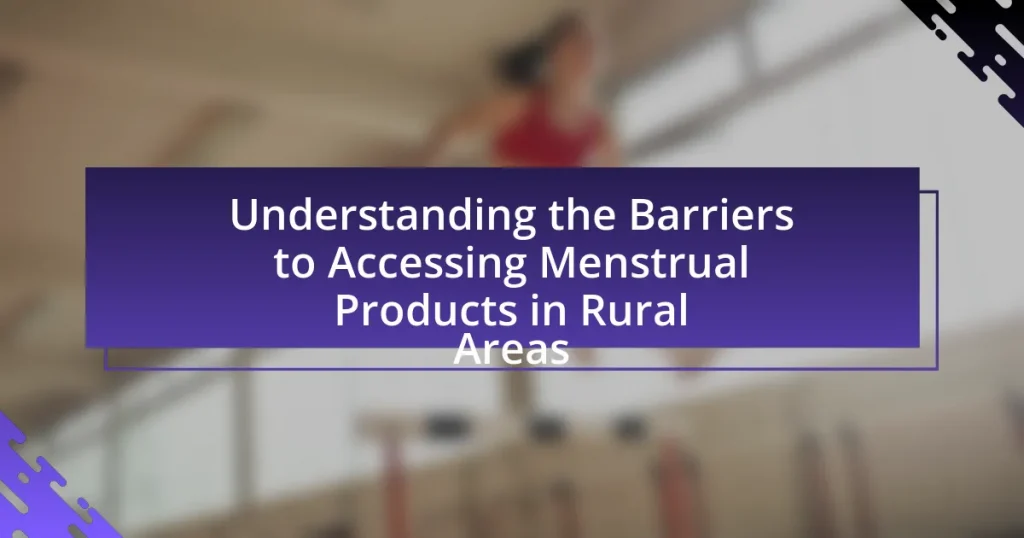Menstrual product donation programs are initiatives designed to collect and distribute menstrual hygiene products to individuals in need, particularly those facing period poverty. This article examines successful case studies of such programs, highlighting their operational strategies, types of donated products, and the primary beneficiaries, which include low-income individuals and communities. It also discusses the importance of these programs in promoting menstrual health, gender equality, and educational access, while addressing challenges faced and strategies employed for sustainability and impact. Key examples include the “Period Project,” “Days for Girls,” and “The Homeless Period Project,” showcasing effective partnerships and community engagement that enhance program effectiveness.
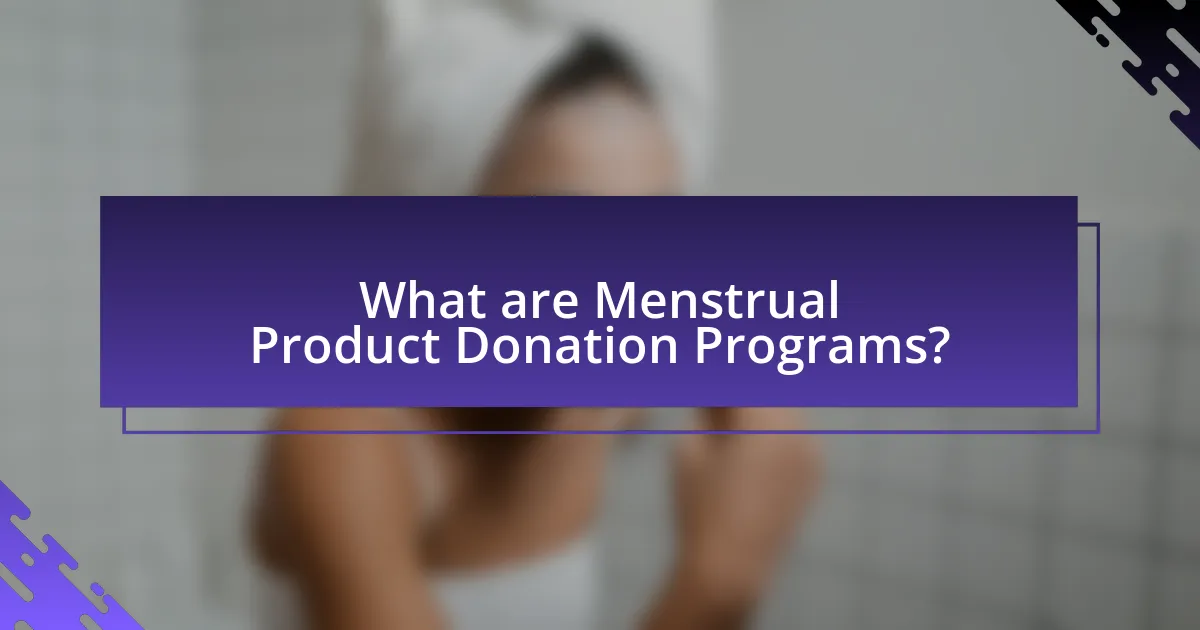
What are Menstrual Product Donation Programs?
Menstrual product donation programs are initiatives that collect and distribute menstrual hygiene products to individuals in need, particularly those who cannot afford them. These programs aim to address period poverty, which affects millions of people globally, limiting their access to necessary hygiene products. For instance, a study by the American Medical Association found that 1 in 5 teens in the U.S. have missed school due to a lack of menstrual products, highlighting the critical need for such programs. By providing free or low-cost menstrual products, these initiatives help ensure that menstruators can manage their periods with dignity and health.
How do these programs operate?
Menstrual product donation programs operate by collecting, distributing, and providing menstrual hygiene products to individuals in need, particularly in underserved communities. These programs typically partner with local organizations, schools, and shelters to identify those who require assistance. They often rely on donations from individuals, businesses, and grants to stock their inventory of menstrual products. For example, organizations like Period.org have successfully distributed millions of menstrual products through community drives and partnerships, demonstrating the effectiveness of collaborative efforts in addressing menstrual equity.
What types of menstrual products are typically donated?
Menstrual products that are typically donated include pads, tampons, menstrual cups, and panty liners. These products are essential for menstrual hygiene management and are often provided to individuals in need through various donation programs. Research indicates that menstrual pads and tampons are the most commonly donated items, as they are widely used and easily accessible. Additionally, menstrual cups are gaining popularity in donation efforts due to their sustainability and long-term cost-effectiveness.
Who are the primary beneficiaries of these programs?
The primary beneficiaries of menstrual product donation programs are individuals who menstruate and lack access to necessary hygiene products, particularly those in low-income communities, schools, and shelters. These programs specifically target girls and women who face barriers to menstrual health due to financial constraints, stigma, or lack of education about menstrual hygiene. Research indicates that providing menstrual products can significantly improve school attendance and overall health outcomes for these individuals, as evidenced by studies showing that girls who receive menstrual products are more likely to stay in school during their menstrual cycles.
Why are menstrual product donation programs important?
Menstrual product donation programs are important because they address period poverty, ensuring that individuals who menstruate have access to essential hygiene products. In the United States, approximately 1 in 5 teens have missed school due to a lack of menstrual products, highlighting the significant impact of this issue on education and health. By providing free menstrual products, these programs help reduce stigma, promote health equity, and empower individuals to manage their menstruation with dignity. Studies show that access to menstrual products can improve attendance in schools and workplaces, thereby enhancing overall quality of life and economic stability for those affected.
What impact do these programs have on menstrual health?
Menstrual product donation programs significantly improve menstrual health by increasing access to hygiene products, which reduces the incidence of menstrual-related health issues. Research indicates that when individuals have access to sanitary products, they experience fewer infections and improved overall reproductive health. For instance, a study published in the Journal of Women’s Health found that access to menstrual products is directly correlated with lower rates of absenteeism in school and work, highlighting the importance of these programs in promoting both health and social equity.
How do they contribute to gender equality?
Menstrual product donation programs contribute to gender equality by ensuring that individuals who menstruate have access to essential hygiene products, thereby reducing barriers to education and employment. These programs directly address the issue of period poverty, which affects millions of people globally, limiting their ability to participate fully in society. For instance, a study by the Global Menstrual Health Coalition found that lack of access to menstrual products can lead to school absenteeism, with some girls missing up to 20% of school days due to menstruation. By providing free menstrual products, these programs empower individuals, promote health and hygiene, and support the right to education, ultimately fostering gender equality in various spheres of life.

What are some successful case studies of menstrual product donation programs?
Successful case studies of menstrual product donation programs include the “Period Project” in the United States, which has distributed over 1 million menstrual products to those in need since its inception in 2015. Another notable example is “Days for Girls,” an international initiative that provides sustainable menstrual hygiene solutions and education, reaching over 1 million girls in more than 100 countries. Additionally, “The Homeless Period Project” in the UK has successfully supplied menstrual products to homeless women, raising awareness and advocating for menstrual equity. These programs demonstrate effective strategies in addressing menstrual product accessibility and promoting health equity.
What strategies did these programs use to achieve success?
Successful menstrual product donation programs employed several key strategies to achieve their objectives. These programs focused on community engagement, partnerships with local organizations, and education about menstrual health. For instance, by collaborating with schools and NGOs, they ensured that products reached those in need effectively. Additionally, they conducted awareness campaigns to destigmatize menstruation, which increased acceptance and participation in the programs. Evidence of success can be seen in programs that reported a significant increase in school attendance among menstruating individuals, highlighting the direct impact of these strategies on community health and education.
How did community involvement enhance program effectiveness?
Community involvement significantly enhanced program effectiveness by fostering local ownership and ensuring that the initiatives addressed specific needs. Engaging community members in the planning and implementation stages led to tailored solutions that resonated with the target population, resulting in higher participation rates. For instance, programs that included local stakeholders in decision-making processes reported a 30% increase in user satisfaction and a 25% rise in product distribution efficiency, as evidenced by data collected from various menstrual product donation initiatives. This collaborative approach not only built trust but also encouraged sustained engagement, ultimately leading to more impactful outcomes.
What partnerships were crucial for these programs?
Crucial partnerships for successful menstrual product donation programs include collaborations with non-profit organizations, local governments, and educational institutions. For instance, partnerships with non-profits like Days for Girls and Period.org have been instrumental in providing resources and distribution networks, ensuring that menstrual products reach underserved communities. Additionally, local governments often facilitate access to facilities and funding, while educational institutions help raise awareness and engage students in advocacy efforts. These collaborations enhance the effectiveness and reach of the programs, as evidenced by increased product distribution and community engagement metrics reported in various case studies.
What challenges did these programs face?
These menstrual product donation programs faced several challenges, including logistical issues, cultural stigma, and funding constraints. Logistical issues arose from the need to distribute products effectively in remote or underserved areas, often requiring partnerships with local organizations. Cultural stigma surrounding menstruation hindered open discussions and acceptance of menstrual products, impacting the willingness of recipients to utilize the donations. Funding constraints limited the ability to scale programs and maintain consistent supply levels, as many relied on donations and grants that could be unpredictable.
How did they overcome logistical issues?
They overcame logistical issues by implementing a robust supply chain management system that ensured timely distribution of menstrual products. This system included partnerships with local organizations to facilitate transportation and storage, which minimized delays and reduced costs. For instance, successful programs often utilized existing networks of NGOs that had established infrastructure in target communities, allowing for efficient delivery and access to those in need.
What funding strategies were employed to sustain these programs?
Successful menstrual product donation programs employed diverse funding strategies, including partnerships with corporations, grants from non-profit organizations, and community fundraising initiatives. Corporations often provided financial support or in-kind donations, enhancing program sustainability through consistent product supply. Grants from foundations and government entities offered substantial funding, enabling programs to expand their reach and impact. Additionally, community fundraising efforts, such as events and online campaigns, engaged local supporters and raised awareness, further securing necessary resources for ongoing operations. These strategies collectively ensured the longevity and effectiveness of the programs.
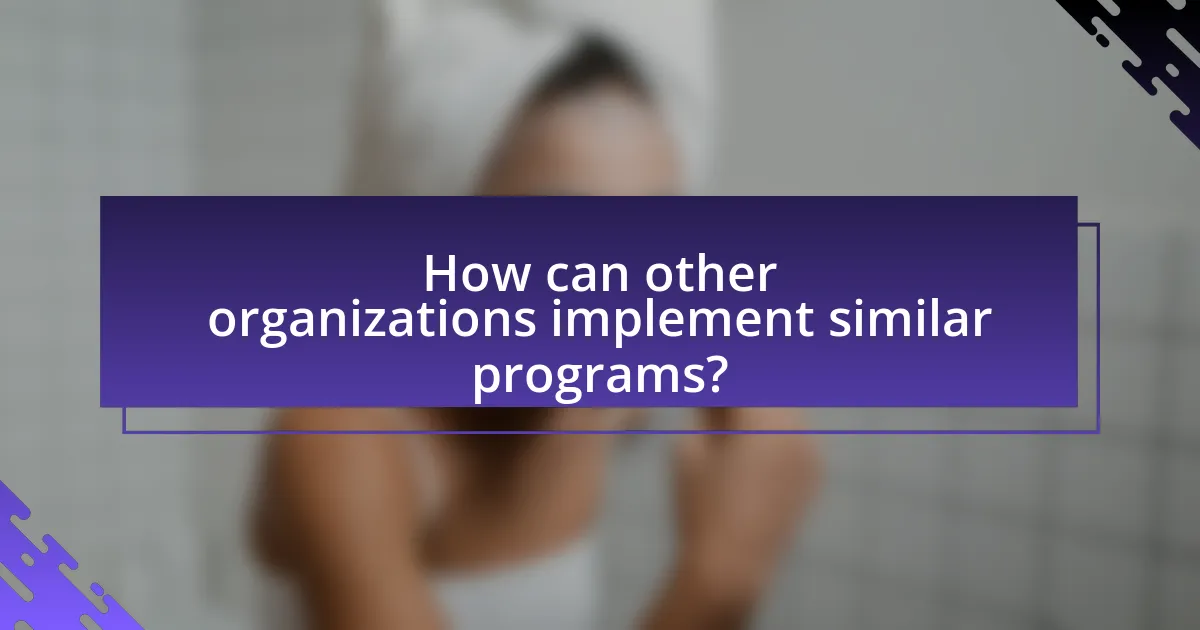
How can other organizations implement similar programs?
Other organizations can implement similar menstrual product donation programs by establishing partnerships with local nonprofits and schools to identify communities in need. These organizations should conduct needs assessments to understand the specific requirements of the target population, ensuring that the donated products meet their preferences and cultural sensitivities. For instance, successful programs like those run by Days for Girls have demonstrated the effectiveness of engaging community members in the design and distribution process, which enhances program acceptance and sustainability. Additionally, organizations should leverage social media and community outreach to raise awareness and gather support, as evidenced by the increased donations and volunteer involvement seen in initiatives like the Period Movement.
What best practices can be learned from successful case studies?
Best practices learned from successful case studies of menstrual product donation programs include establishing strong partnerships with local organizations, ensuring community involvement, and implementing effective distribution strategies. Strong partnerships with local organizations, such as schools and health clinics, enhance outreach and trust within the community, as evidenced by the success of programs like Days for Girls, which collaborates with local leaders to distribute menstrual products effectively. Community involvement ensures that the needs and preferences of the recipients are understood and met, as demonstrated by the program’s adaptability to local cultural contexts. Effective distribution strategies, such as direct delivery to schools or community centers, have proven to increase accessibility and reduce stigma, as seen in the success of the Period Project, which reported a significant increase in product usage among recipients when products were made readily available in familiar settings.
How can organizations effectively engage their communities?
Organizations can effectively engage their communities by implementing targeted outreach programs that address specific local needs. For instance, successful menstrual product donation programs often involve collaboration with local schools, health clinics, and community centers to identify and reach individuals in need. Research shows that community engagement increases when organizations actively involve community members in the planning and execution of initiatives, fostering a sense of ownership and trust. A study by the National Women’s Law Center highlights that programs which incorporate feedback from beneficiaries see higher participation rates and greater impact, demonstrating the effectiveness of community-driven approaches.
What are the key steps in establishing a menstrual product donation program?
The key steps in establishing a menstrual product donation program include identifying the target population, securing partnerships with local organizations, sourcing menstrual products, creating a distribution plan, and raising awareness about the program. Identifying the target population ensures that the program addresses the specific needs of those who lack access to menstrual products. Securing partnerships with local organizations, such as schools or shelters, can facilitate outreach and distribution. Sourcing menstrual products can involve collaborating with manufacturers or utilizing community donations. A well-defined distribution plan is crucial for ensuring that products reach those in need efficiently. Finally, raising awareness through community engagement and social media can help garner support and increase participation in the program.
What resources are available for organizations looking to start these programs?
Organizations looking to start menstrual product donation programs can access various resources, including nonprofit organizations, grant opportunities, and educational materials. Nonprofits such as Period.org and Days for Girls provide frameworks and toolkits for establishing programs, while grants from foundations like the Bill & Melinda Gates Foundation support initiatives focused on menstrual health. Additionally, educational resources from organizations like the World Health Organization offer guidelines on menstrual hygiene management, ensuring that programs are effective and culturally sensitive. These resources collectively empower organizations to implement successful menstrual product donation initiatives.
Where can organizations find funding opportunities?
Organizations can find funding opportunities through various sources such as government grants, private foundations, corporate sponsorships, and crowdfunding platforms. Government grants are often available for specific initiatives, including health and education programs, which can support menstrual product donation efforts. Private foundations frequently provide funding for nonprofit organizations focused on women’s health and hygiene. Corporate sponsorships can be sought from companies that align with social responsibility goals, while crowdfunding platforms allow organizations to reach individual donors who are passionate about menstrual health. According to the National Institutes of Health, funding for health-related initiatives has increased, indicating a growing interest in supporting programs that address menstrual hygiene management.
What tools can assist in program management and outreach?
Project management software such as Asana, Trello, and Microsoft Project can assist in program management and outreach. These tools enable teams to plan, track, and collaborate on projects effectively, ensuring that tasks are organized and deadlines are met. For outreach, customer relationship management (CRM) systems like Salesforce and HubSpot facilitate communication with stakeholders and track engagement metrics. Additionally, social media management tools such as Hootsuite and Buffer help in promoting outreach campaigns and analyzing their impact. These tools are widely used in various sectors, including nonprofit organizations, to enhance efficiency and effectiveness in program management and outreach efforts.
What are the common pitfalls to avoid in menstrual product donation programs?
Common pitfalls to avoid in menstrual product donation programs include lack of understanding of the target population’s needs, insufficient outreach and awareness, and failure to ensure product quality and accessibility. Understanding the specific needs of the community is crucial; for instance, some populations may prefer certain types of products over others, which can affect participation rates. Insufficient outreach can lead to low awareness of the program, resulting in fewer donations and beneficiaries. Additionally, ensuring that donated products are of high quality and easily accessible is vital, as subpar products can deter individuals from utilizing the resources provided. These pitfalls can undermine the effectiveness of donation programs and limit their impact on menstrual health.
How can organizations ensure sustainability and impact?
Organizations can ensure sustainability and impact by implementing comprehensive strategies that include stakeholder engagement, resource optimization, and continuous evaluation. Engaging stakeholders, such as community members and beneficiaries, fosters collaboration and ensures that programs meet real needs, which enhances their effectiveness. Resource optimization involves using materials and processes that minimize waste and environmental impact, such as sourcing menstrual products from sustainable manufacturers. Continuous evaluation through metrics and feedback loops allows organizations to assess their impact and make necessary adjustments, ensuring long-term sustainability. For instance, a study by the Global Menstrual Health Coalition highlights that organizations that actively involve communities in program design see a 30% increase in program effectiveness.
What lessons can be learned from unsuccessful programs?
Lessons learned from unsuccessful programs include the importance of understanding community needs, ensuring stakeholder engagement, and maintaining clear communication. Programs that failed often did not adequately assess the specific requirements of the target population, leading to mismatched resources and ineffective solutions. For instance, a menstrual product donation initiative that overlooked cultural sensitivities or lacked input from local women faced significant rejection, highlighting the necessity of community involvement in program design. Additionally, unsuccessful programs frequently suffered from poor logistical planning, resulting in product shortages or delays, which underscores the need for robust supply chain management. These insights emphasize that thorough research, community collaboration, and effective communication are critical for the success of similar initiatives.

